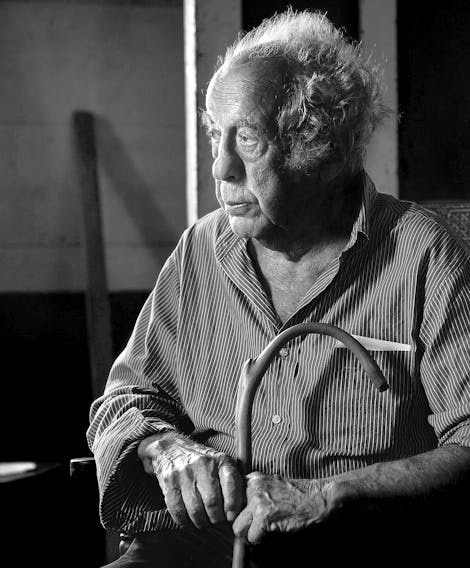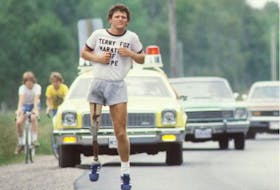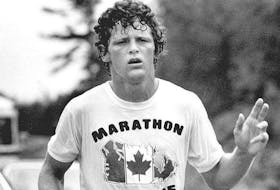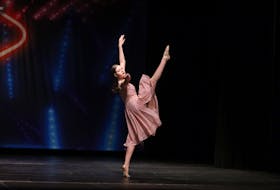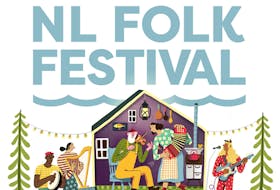Robert Frank, one of the most influential photographers of the 20th century, died Monday in Inverness, N.S. Here's a feature story from our archives, originally published in 2014, after features writer Lois Legge and photojournalist Adrien Veczan visited him at his Mabou summer home.
By LOIS LEGGE
MABOU, N.S. — Robert Frank transformed photography with the 1959 publication of his seminal book The Americans to become one of the most influential photographers of our time. Writer Lois Legge met with Frank, 89, for a rare interview at his summer home in Mabou, where memories of The Rolling Stones and Jack Kerouac intermingled with stories of light, loss and love.
Waves of light and shadow brush Robert Frank’s face. And the famous photographer smiles.
“I just thought it was one of the best places I’d ever seen," says the man of many pictures, many places, sitting high on a hill in Mabou, Cape Breton, where sea winds howl and a clock chimes out the hours.
Far away from desolate highways and the road with the Rolling Stones; old friendships with Jack Kerouac and Allen Ginsberg — and his days immortalizing the unknown.
Frank came here for “peace" more than 40 years ago, to escape the fame that followed his seminal, searing 1959 book The Americans — 83 images of black and white, so riveting, so revolutionary that experts place him among the most influential photographers of the 20th century.
So innovative, as Kerouac writes in the introduction, he “sucked a sad poem right out of America . . . taking rank among the tragic poets of the world."
These days, the revered, often-reclusive artist is more content to escape the world, coming back again and again to what he calls the “lonely," “exceptional," “heavenly" place that has eased his own tragic losses. A place where he shares a leisurely, creative life with his second wife, June Leaf, the accomplished painter and sculptor, the “very smart," “ very strong" woman he fell in love with “at first sight" many years ago.
And a place where he’s created other sad poems, in haunting pictures and sombre films, as memorials to his late daughter and son.
The 89-year-old doesn’t take pictures anymore.
Some things are unforgettable
And his memory fades as the clock on his wall echoes 10, 11, 12. As breezes rise up from the ocean, past tall, reedy grasses, through white cotton curtains to the cavernous kitchen of the old, ramshackle former fisherman’s house that’s been his summer (and, sometimes, winter) home for decades.
“The march of time," he says wryly, resigned to the lapses of dates and details that punctuate parts of his past.
But what he remembers, he remembers well.
His iconic, celebrated work.
His daughter Andrea, who died in a fiery plane crash; his son Pablo, who had schizophrenia and died in a psychiatric hospital.
His year on the road with the Rolling Stones, filming the infamous, fascinating, drugs- and sex-fuelled 1972 documentary Cocksucker Blues.
And his life beyond the borders of convention: the highs of creativity and acclaim; the lows of lingering loss. “Losing your memory is kind of funny," says the Swiss-born, New York-based innovator, whose forgetfulness is a result of age, not illness.
“So maybe you try to make sure some things you don’t forget and some things you do remember.
“I don’t forget my children, the relationship I had with them and, you know, it was often painful. What would have been better in the relationship and how I could have made it better. And these are the things that haunt you. . . . You have good memories to help you, but they don’t do the whole job."
Some of his memories are vivid, some complex, some as mysterious and shadowy as the chromatic, ghostly glow of a New York City jukebox. Or a black man’s plaintive stare on the back of a New Orleans bus. Or a long, lonesome New Mexico highway.
Or all the other mesmerizing, haunting shades of America he captured with his little 35-millimetre camera long ago, using the black and white film he loves — “the vision of hope and despair," as he said then; “the colour of photography," as he says now.
They are “completely revolutionary" visions that Sarah Greenough, senior curator and head of photography for the National Gallery of Art in Washington. D.C, says shook photography “to the core."
And they rocked what Greenough calls the “simplistic," “wholesome" image of America portrayed in magazines like Life and Look, before Frank received a prestigious Guggenheim Fellowship and hit the back roads, highways and streets of the United States in 1955 and ’56 for the trail-blazing book first published in France (1958), then the U.S. (1959).

Icon with unique style
The Americans revealed the racism, economic divide and political hypocrisy that lay “beneath the surface," says Greenough, whose gallery, thanks to Frank’s donations, owns the largest collection of his photographs, including all the negatives, contact sheets and prints from The Americans.
“But he also discovered such moments of joy and beauty in American life as well, in places that people really hadn’t looked before — you know, cars, jukeboxes, the road itself. He sort of redefined what the icons of American life were."
Eventually, he became an icon himself, lauded for his unique style, his camera sometimes out of focus or tilted at odd angles, “his tendency of getting very close to people, almost looking over their shoulder as if to suggest that you, the viewer, are standing there right next to him."
Greenough has worked closely with Frank while organizing two major exhibits of his work, including the 50th anniversary retrospective Looking In: Robert Frank’s The Americans (2009), also shown at New York’s Museum of Modern Art and the San Francisco Museum of Modern Art, among the many major museums or galleries to feature his work over the years.
But she finds something new each time, “like a beautiful piece of poetry that you can go back to again and again."
“Robert is one of if not the most important 20th-century photographers, one of the most important 20th-century artists in general," she says. “History has shown that for the last 50 years with the publication of The Americans, and I think it will continue to show that in the future. His impact on 20th-century photography was profound and very long-lasting."
It often seemed too long-lasting for Frank. He has spent his life shunning repetition, stepping outside the frames of convention, even as a boy in neutral Switzerland during the Second World War, when he lived what he calls a “bourgeois life" in an upper-middle-class Jewish family while “the threat of Hitler was all around."
His father was among the German Jews whom Hitler stripped of their citizenship and he lived stateless in Switzerland, a precarious though comfortable life considering the death camps just beyond the borders. Frank remembers him as a “bon vivant" who “wasn’t interested in his children."
“I think that happens sometimes," he says simply, as Leaf heats coffee on an old-fashioned stove, the window curtains unfurl, the waves loop along the Gulf of St. Lawrence below.
His mother was an “invalid," “an unhappy woman" who progressively started losing her sight when he was about 10 or 12. His older brother had several marriages and children but couldn’t get a job and depended on the family for support.
“I wouldn’t describe it as a happy family," he says.
Frank spent his time studying, climbing the mountains near Zurich and picking up a camera, which “seemed to be a good way to find independence."
As time passed, he became a serious photographer, studied and apprenticed with several Swiss professionals and gradually edged out of the “ordinary," “comfortable life" he never wanted.
“I wanted to get away. . . . I wanted to get away from the family, from being connected with that life. There was no other way than to go away. I mean, the influence of being there, and living in that milieu . . . was too strong, and if I would have stayed there, no matter what, I would have become like that."
New York to Peru and back again
Instead, he went to Paris and then to America, to New York City, where he soon connected with top fashion magazines like Harper’s Bazaar, taking pictures of objects for the back of the magazine for $25 or $30 apiece, “lucky" to have the job but not interested in the pursuit of money. And “restless" for something more.
So he went to Peru, a “beautiful and empty" country where he took bus rides alone through the mountains and snapped pictures of the nomadic people and the stark sun-drenched landscape.
“You can only do that when you’re alone, really," he says. “You couldn’t do it with a wife."
But he returned to New York City and married his first wife, Mary, an artist; they had two children.
They lived in Greenwich Village, the epicentre of Beat culture, where he later met and became friends and artistic collaborators with creative, free-thinking writers like Ginsberg and Kerouac, an “aggressive," “unusual" genius whose words rocked the literary world like “fabulous yellow roman candles exploding like spiders across the stars." (On The Road) Frank still smiles about some of the Beat writer’s wild, outrageous words to strangers: “Did you clean your asshole today?"
But he laments his friend’s sad ending: Kerouac burned out, fighting fame and drinking himself to death by 1969.
Ginsberg (Howl and Other Poems) was “a prophet," “an exceptional brain" who remained a “kind," close friend until he died in 1997.
“I was lucky, I think," Frank says of those friendships, which eventually led to the filmmaking collaboration with Kerouac and Ginsberg on Pull My Daisy, an experimental black and white short considered a forerunner to the indie film movement.
“It was a very interesting group, Ginsberg, Kerouac. They were independent and they were doing their own thing and they were creative people and you could feel that. And I felt I fit in. They were my kind of people."
But before all that, before those days with the iconic, creative figures of the late 1950s and ’60s, Frank saw the people — the places, the objects — of America.
He was often alone. He sometimes took his wife and two small children, long before Andrea grew up and came to Mabou. Long before she flew in 1974 to the archeological site of Tikal, Guatemala, and died in a small plane crash near the ruins. Long before Pablo’s schizophrenia and the revolving doors of institutions, “a very hard . . . very depressing time," and then his death in 1994.
A picture of them as little children, bundled with Mary in his car on the side of a highway, is the last photograph in The Americans.
Today, his memories of those days on the road sometimes click into sharp focus, sometimes wither away, blurred by time rather than the trail-blazing kilter of his camera.
But key moments and impressions remain, just like photographs, which he calls “a collection of memories."
“I could see right away there were very good parts, sides of America," says Frank, welcoming and friendly, reflective and funny — sometimes melancholy — on this hot July day along the windswept paradise he chose because “it was like heaven, in a way," away from New York, where “too many people knew me and too many people sniffing you out."
“But there also (was) a part of hating other people because they are (a) different race or they don’t fit in," he says of 1950s America.

The sting of prejudice
Frank found himself drawn to the black men, women and children in the then-segregated South, producing images of stark racism, as well as beauty, dignity and compassion, that are among his most famous, like the segregated New Orleans streetcar that graced the cover of the U.S. edition of the book, which also contained Kerouac’s transcendent introduction.
“I did like the black people" he says, remnants of a Swiss accent lingering. “They were considered by many Americans as lower-class and I had very deep sympathy for that. You find that in Europe, too, but here, it was very strong and so, I mean, it made a big impression on me. . . . Maybe being Jewish, it had to do with having to work hard to be accepted."
Frank himself felt the sting of prejudice along the way.
In Arkansas, police stopped his car and checked his papers, surmised he was Jewish and accused him of being a Communist. They arrested him, fingerprinted him and put him in jail.
“They were very primitive," he recalls. “I mean they said, ‘You’re Jewish; we’ll have to get a Jew to interview you.’ You’re a ‘Communist’ — that was the word they used all the time." Frank spent a night in jail but says he wasn’t that worried about getting out.
“When you are young, you think everything will be OK. They’ll let you go; of course they’ll let you go."
He grins. “In Arkansas, they had nothing else to do."
But the young photographer met many “generous," “not closeminded," Americans, too, admired their freedom and “largesse"; and “worked hard" taking thousands of pictures, from the factories of Detroit to the fields of South Carolina. The images ranged from a black man’s funeral to a white starlet’s Hollywood premiere to an elevator operator’s cool, bored stare amid the shadowy figures on the edges. He later meticulously sequenced them in complex, compelling contrasts that made viewers stop and look and think — and look again.
Frank thinks back to one of his favourites, of a black couple sitting on a hill overlooking San Francisco’s whitewashed buildings.
He sat behind them, trying not to be noticed. But they turned and looked directly into his camera, giving him “that look you often get as a photographer," he says. Often, when you “intrude in their privacy," “you don’t catch it."
This time, he caught it.
“This whole view of these two black people there and you look down and you see the white city. I think there’s more to that, there’s more to that picture than I’m saying.
“I knew that was a good picture."
'Profoundly moved'
Not everyone felt the same about this or any of Frank’s pictures, which were excoriated, at first, as an angry, bleak view of the country.
“Some people thought I hated the country," he says. “They thought that it was ungrateful for a visitor to come and make a picture of America like that, but I think that changed."
Greenough, who has written extensively about Frank’s work, recalls the sometimes strongly negative initial reaction to The Americans. “One person proposed that Robert should have called the book Why I Can’t Stand America. Another person, sort of playing on Kerouac’s ideas . . . said it was ‘a sad poem for sick people.’ " But attitudes changed dramatically, says Greenough. As time passed, younger photographers discovered the pictures and were “profoundly moved, so that by the time the book was reprinted in the late 1960s, all of the reviews were exceptionally positive from that point on."
Frank was happy about the recognition at first, and he embraces the book today — the places and faces he captured, the pictures he hopes show “the dignity of people."
But, for a long time, says Greenough, they “hung like an albatross around his neck" and he abandoned photography and switched to film because he didn’t want to repeat himself. It was a “brave" move from one of the most “principled," “uncompromising" artists she’s ever met.
“In some ways, he was very much like a rock star who gets known for one particular song. Every time that rock star goes to a concert, people expect him or her to sing that song, and Frank just refused to do that, refused to be pigeonholed that way. And I think that makes him a far more fascinating artist — that restlessness, that continual pushing that one sees in his work and in his personality as well."
That risk taking, the photographer agrees, is something he’s always embraced. “I was afraid to repeat in the work, always," he says. “If you have to repeat something based on your own work, it becomes weaker. It’s a way of sort of sliding down. You should turn to something that’s new and never done before, even if you don’t succeed.
“My films were not successful; nevertheless, I kept myself from repeating the photography that I did."
Perhaps his best-known but least-seen film is Cocksucker Blues, commissioned by the Rolling Stones after Frank shot the album cover for Exile on Main St. He spent a year with the Stones on their 1972 North American tour, capturing the gritty, unglamorous details of their backstage life. And then they sued to stop the film’s release.
But Frank made no judgments then and feels no bitterness now.
“You just try to capture it," he says of those days with the “pleasant, easygoing" band members. “You don’t have moral judgment. . . . It’s the one time you have that chance. It doesn’t come back."
But the backstage footage proved a bit too real and Frank eventually reached a settlement with the group, agreeing not to show the film unless he was present and not more than “six times a year or something like that."
The band paid for the film and had the rights to it, he says, so he has no hard feelings.
These days, grainy contraband clips — groupie sex, drug use galore — can still be found on YouTube.
And some of the after-effects of the experience still make him and Leaf laugh.
Like the day a sheriff from Port Hood showed up at their door in Mabou to confiscate Frank’s copy. The photographer-filmmaker offered him a chair and brought out a canister of film.
“I gave him the wrong can," he says. “He didn’t know I gave him the wrong can."
Then there was the stir the strangers from New York caused in this tiny, tight-knit community, although only an old fisherman nicknamed Cu (Gaelic for dog) dared to ask what all the talk was about.
“He said, ‘Well, Robert, what’s the beef?’ " Leaf recalls. “He didn’t buy all the hype . . . and I loved that."
Painful memories of his children
But the room becomes quiet, sombre, when talk turns to Frank’s children. “You can’t deal with it," he says, his voice and his gaze dropping. “It’s fate."
He brings up Andrea, “a very happy child."
He thinks about Pablo but says: “It’s too hard for me to talk about."
A few weeks later, he talks a little.
Through the years, Frank has explored his sometimes strained relationship with his children in films and pictures.
In the film Conversations in Vermont (1969), the teenagers are living away from New York at a commune-style boarding school, where he reminds Andrea of her wish for normal parents.
In the 1980 film Life Dances On, he asks Pablo, “Why do you have to carry the whole world on your shoulders?" His son answers: “Because I don’t like earth’s gravity. . . . I want to investigate Mars."
Then, in Home Improvements (1985), he films Pablo in a mental hospital. “As I walk back from the visit with Pablo, I always have hope but I realize that . . . I would try, and I think it means a lot to him if I try; he knows that I’m trying. I just don’t know how long I can do it."
Pictures explore the painful subject, too, like the dual image he created after Andrea’s death, his hand holding a tiny, skeleton-like figure above the Mabou horizon, with empty mirrored images interspersed with scrawled, dripping words: Sick of Goodby’s.
“She grew up in a family that was not the ordinary," he says of his daughter, shown smiling, running up to kiss her father in Conversations in Vermont, a film he says “I’m very glad I made . . . because they’re not here anymore."
“I wanted them to be free to just talk about how they felt about being in this family and living with me. And we separated, their mother and me . . . so I think it was sort of a hard time then for them."
And a hard time for Frank, too, facing his daughter’s death and his son’s descent into mental illness and despair.
“We tried to get him out (of hospitals) to find another solution for his life," he says. “That was a difficult time.
“It makes it easier if you . . . express your feelings and sadness. That was sort of necessary for me to have something I could do, to deal with it."
Leaf has made it easier too and so has being in Mabou, where Frank gets up from the table, takes off his shoes and walks out into the vast, rolling openness.
In the past, he’s often quoted the poet Antoine de Saint-Exupery: “It is only with the heart that one can see rightly; what is essential is invisible to the eye."
Today, he looks out at the sea.
“It’s a happy thing that happened to me to be able to be here," he says as the sun beams down and the waves crash and Leaf walks out to join him. “My two children died and so you think about life but . . . who couldn’t be happy to sit here?"

